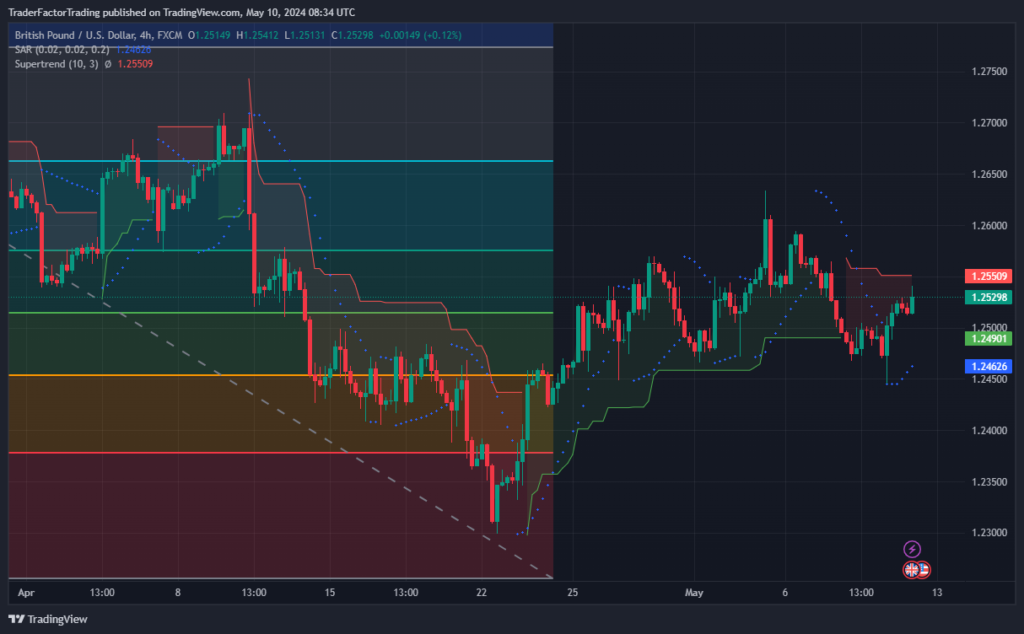The GBP/USD currency pair rose to near 1.2540 during the Asian trading session on Friday, following the release of stronger-than-anticipated UK Gross Domestic Product (GDP) data for the first quarter of 2024. This development provides a unique perspective on the dynamics influencing the GBP/USD pair, amidst a backdrop of decisions and statements from the Bank of England (BoE) and the US labor market.
GBP/USD Chart

Table of Contents
ToggleSurprising GDP Growth Spurs Optimism
The UK economy showcased resilience and strength with the GDP expanding by 0.6% in the first quarter of 2024. This marked a significant rebound following declines of 0.3% and 0.1% in the preceding two quarters, respectively. The growth was widespread across various sectors, with notable performances in services and production, although construction lagged behind.
The Impact of BoE’s Stance
Despite the positive GDP figures, the Pound Sterling faced challenges after the BoE’s decision to hold the interest rate steady at 5.25%. BoE Governor Andrew Bailey hinted at the possibility of a rate cut in the upcoming month, contingent on further economic data. This announcement introduced volatility into the GBP/USD exchange rate, as traders weighed the implications of future monetary policy adjustments.
U.S. Labor Market and Fed’s Policy Outlook
Adding to the complexity of the GBP/USD trajectory were the latest figures from the US Bureau of Labor Statistics. The reported increase in Initial Jobless Claims to 231,000, against expectations of 210,000, signals potential softening in the labor market. This development could influence the Federal Reserve’s stance, potentially leading to a less hawkish policy outlook, thereby exerting pressure on the US Dollar.
Analyzing the Market Movements
The positive GDP data from the UK presents an intriguing scenario for currency market traders. Typically, strong economic growth bolsters confidence in the respective currency, as it may lead to tighter monetary policy to curb inflationary pressures. However, the nuanced reactions of central banks, such as the BoE’s openness to rate cuts and the Fed’s potential policy shift, introduce layers of complexity in predicting the currency pair’s direction.
Future Outlook and Trader Sentiment
Traders navigating the GBP/USD market must remain vigilant, considering both the macroeconomic indicators and central bank cues. The positive UK GDP data undoubtedly provides a bullish signal for the Pound. Still, the overarching market sentiment will also be shaped by forthcoming economic data, central bank decisions, and geopolitical developments.
Unique Insights on GBP/USD Movement
The BOE’s decision to maintain its interest rate at 5.25% has sent a clear message to the markets about its cautious approach to monetary policy amid uncertain economic conditions. For a deeper exploration of the GBP/USD movement and the interplay between BoE rates and currency dynamics, TraderFactor.com offers comprehensive analysis and insights. This resource can serve as a valuable tool for traders seeking to understand and anticipate shifts in this currency pair.
Conclusion
The recent rise in GBP/USD, driven by positive UK GDP data, highlights the intricate dance between economic indicators, central bank policies, and currency markets. Traders and investors are advised to stay informed and agile, ready to adapt their strategies to a continually evolving landscape. The coming months will be crucial in defining the trajectory of the GBP/USD pair, with every piece of economic data and central bank announcement serving as potential catalysts for movement.
Disclaimer:
All information has been prepared by TraderFactor or partners. The information does not contain a record of TraderFactor or partner’s prices or an offer of or solicitation for a transaction in any financial instrument. No representation or warranty is given as to the accuracy or completeness of this information. Any material provided does not have regard to the specific investment objective and financial situation of any person who may read it. Past performance is not a reliable indicator of future performance.

















